I live and image in a Bortle 7 area. I found that my UV/IR cut clear L filter resulted in unusable Luminance data. Other members of my astronomy society tend to use narrowband images because of similar issues. As a last resort I decided to replace my clear Luminance filter with a dual band filter. In case I miss data at other frequencies I add RGB data divided by an arbitrary value of 4 in Pixinsight/Pixelmath to create a "SuperLuminance". I am quite pleased with the improvement in my images (to my eye at least). I have not seen this method described elsewhere but I am sure that others must be using it. Does anyone have tips for further improvements of this method? Camera: ZWO ASI1600MM Pro (Mono camera) This a crop of M94 from a much wider field (approx one fifth of the original image) taken with Dual Band + (RGB/4) as Luminance and HaRGB Colour: 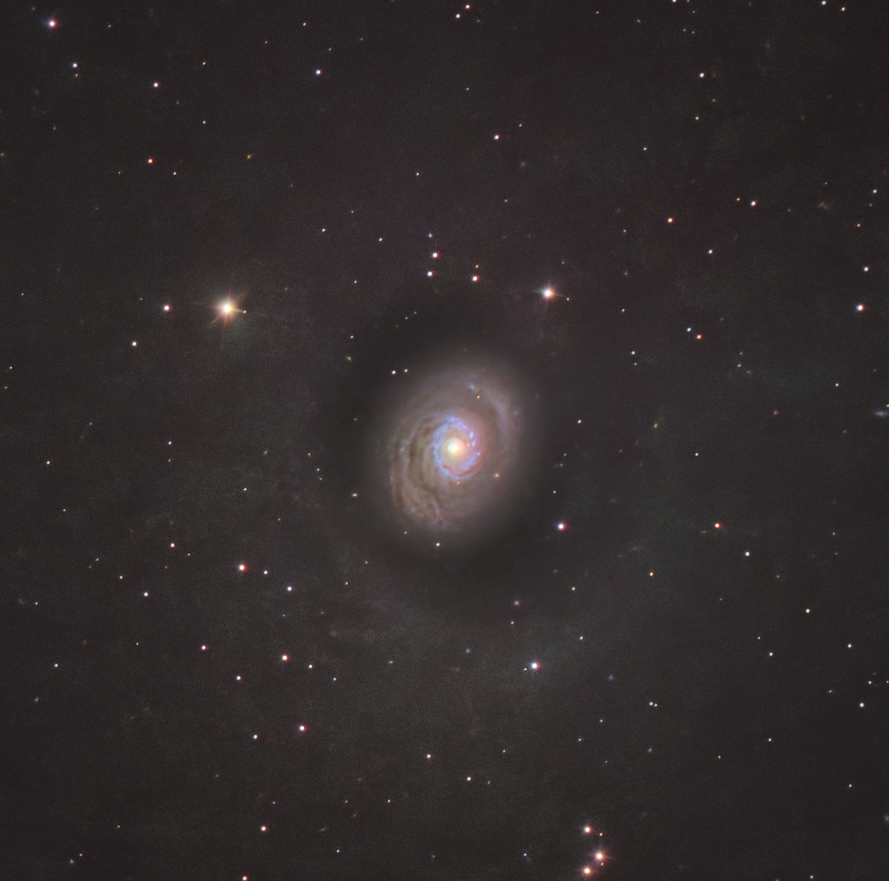 |
You cannot like this item. Reason: "ANONYMOUS".
You cannot remove your like from this item.
Editing a post is only allowed within 24 hours after creating it.
You cannot Like this post because the topic is closed.
Copy the URL below to share a direct link to this post.
This post cannot be edited using the classic forums editor.
To edit this post, please enable the "New forums experience" in your settings.
You cannot like this item. Reason: "ANONYMOUS".
You cannot remove your like from this item.
Editing a post is only allowed within 24 hours after creating it.
You cannot Like this post because the topic is closed.
Copy the URL below to share a direct link to this post.
This post cannot be edited using the classic forums editor.
To edit this post, please enable the "New forums experience" in your settings.
Just last night, I started an excitement, using the lqef in front of my optical train.
And I picked very faint objects for imaging.
Today in going to see the results
It's a 150quattro, with lqef and filter when in serie.
The lqef goes in front of the coma corrector and then the rest until de 2600mm
Last night was great in conditions. All clear, low humidity, and all the big lights were off.
Let's see the results, I'll be posting them here.
Cs!
|
You cannot like this item. Reason: "ANONYMOUS".
You cannot remove your like from this item.
Editing a post is only allowed within 24 hours after creating it.
You cannot Like this post because the topic is closed.
Copy the URL below to share a direct link to this post.
This post cannot be edited using the classic forums editor.
To edit this post, please enable the "New forums experience" in your settings.
John Hulme:
As a last resort I decided to replace my clear Luminance filter with a dual band filter. This is not a sound method. The entire premise of luminance is to capture all the same frequencies as the RGB data, but at a higher signal to noise ratio. Using a dual band filter, especially on broadband targets like this, completely negates any such benefits. You are now no longer imaging the same frequencies, and you have none of the continuum signal left to contribute to the structures of the image. Additionally, you are introducing more noise into the low signal areas of the RGB 'superlum'. If you are having trouble using luminance, I suggest fixing the root cause issue.
|
You cannot like this item. Reason: "ANONYMOUS".
You cannot remove your like from this item.
Editing a post is only allowed within 24 hours after creating it.
You cannot Like this post because the topic is closed.
Copy the URL below to share a direct link to this post.
This post cannot be edited using the classic forums editor.
To edit this post, please enable the "New forums experience" in your settings.
You are essentially missing light signal in pretty much most of the broadband, which are the stars and galaxies and other stellar objects in the sky. Only a tiny fraction of the visible light (OIII) and the Hydrogen alpha - if there is any. Duo band filters are not light pollution filters. They absolutely restrict to near 0% of light entering other than the 2 narrow bands they got open.
If you gonna use a filter for luminance other than a UV/IR, I highly reocmmend to use something like the Baader Moon&Skyglow fliter or as someone pointed out the L-pro or what I tried and seem to work is the Antlia Triband filter. All of these allow light from the entire spectrum of the light, less or more, depending which one you gonna use.
|
You cannot like this item. Reason: "ANONYMOUS".
You cannot remove your like from this item.
Editing a post is only allowed within 24 hours after creating it.
You cannot Like this post because the topic is closed.
Copy the URL below to share a direct link to this post.
This post cannot be edited using the classic forums editor.
To edit this post, please enable the "New forums experience" in your settings.
Maybe not entirely same, but similar … recently a similar method was tried using an SVBONY SV226 quad band filter … on top of a narrow band filter. Worth a view … https://youtu.be/kYQImk6mpnI?si=xGFtl6OI6JKlb7yw |
You cannot like this item. Reason: "ANONYMOUS".
You cannot remove your like from this item.
Editing a post is only allowed within 24 hours after creating it.
You cannot Like this post because the topic is closed.
Copy the URL below to share a direct link to this post.
This post cannot be edited using the classic forums editor.
To edit this post, please enable the "New forums experience" in your settings.
Ok Just finished the experiment. The image is pretty bad. Very noisy and the luminance is not correct. But, I think it's a promising attempt. 8 hours from bortle 6 I think if I add enough lights, eventually would be a pretty decent image. And this image is very difficult, so with bright objects should work better. Cs! 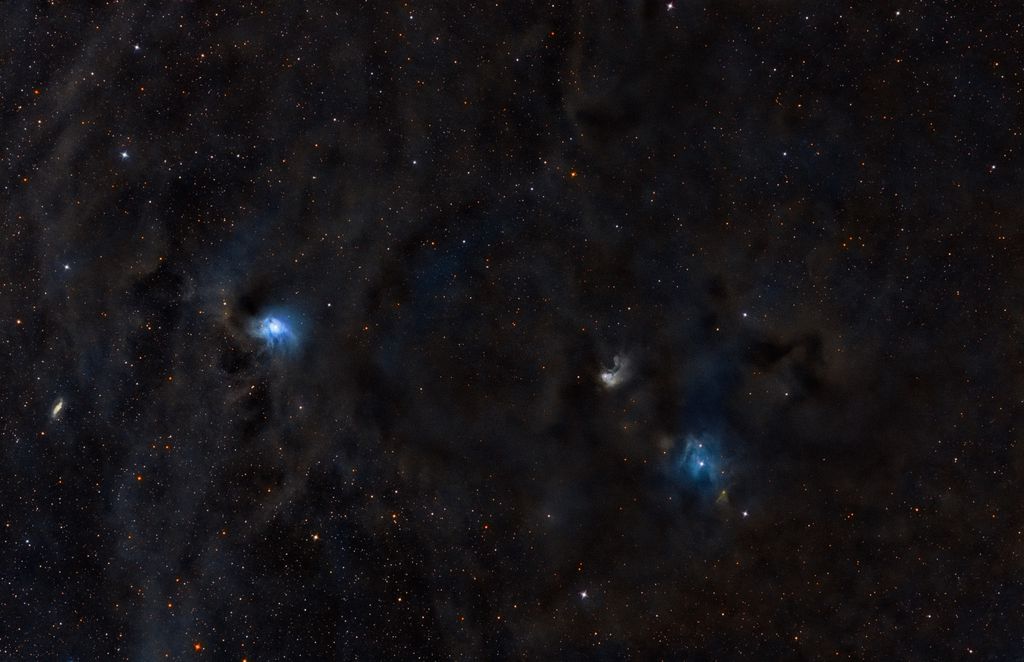 |
You cannot like this item. Reason: "ANONYMOUS".
You cannot remove your like from this item.
Editing a post is only allowed within 24 hours after creating it.
You cannot Like this post because the topic is closed.
Copy the URL below to share a direct link to this post.
This post cannot be edited using the classic forums editor.
To edit this post, please enable the "New forums experience" in your settings.
I have the same issue, it's impossible to capture broadband from my location due to the severe LP, especially when I look south. I've thought of maybe trying a quadband or broadband filter like the l-pro. I wouldn't really use a dualband filter as that would basically be equivalent to using narrowband filters which doesn't work on galaxies.
I've also thought of using an IR pass filter for luminance on dark nebulae and galaxies though that has it's own difficulties and I've never seen anyone use this method to counter light pollution and bad seeing, there must be good reasons for this.
|
You cannot like this item. Reason: "ANONYMOUS".
You cannot remove your like from this item.
Editing a post is only allowed within 24 hours after creating it.
You cannot Like this post because the topic is closed.
Copy the URL below to share a direct link to this post.
This post cannot be edited using the classic forums editor.
To edit this post, please enable the "New forums experience" in your settings.
Although when everything is said and done you can still get "some" images with dual NB filters (6-7nm bandwidth) with "some" spiral galaxies, see below (entirely dual NB, ASKAR and L-Extreme). Just a quick and dirty processing but to illustrate the concept it shall suffice: 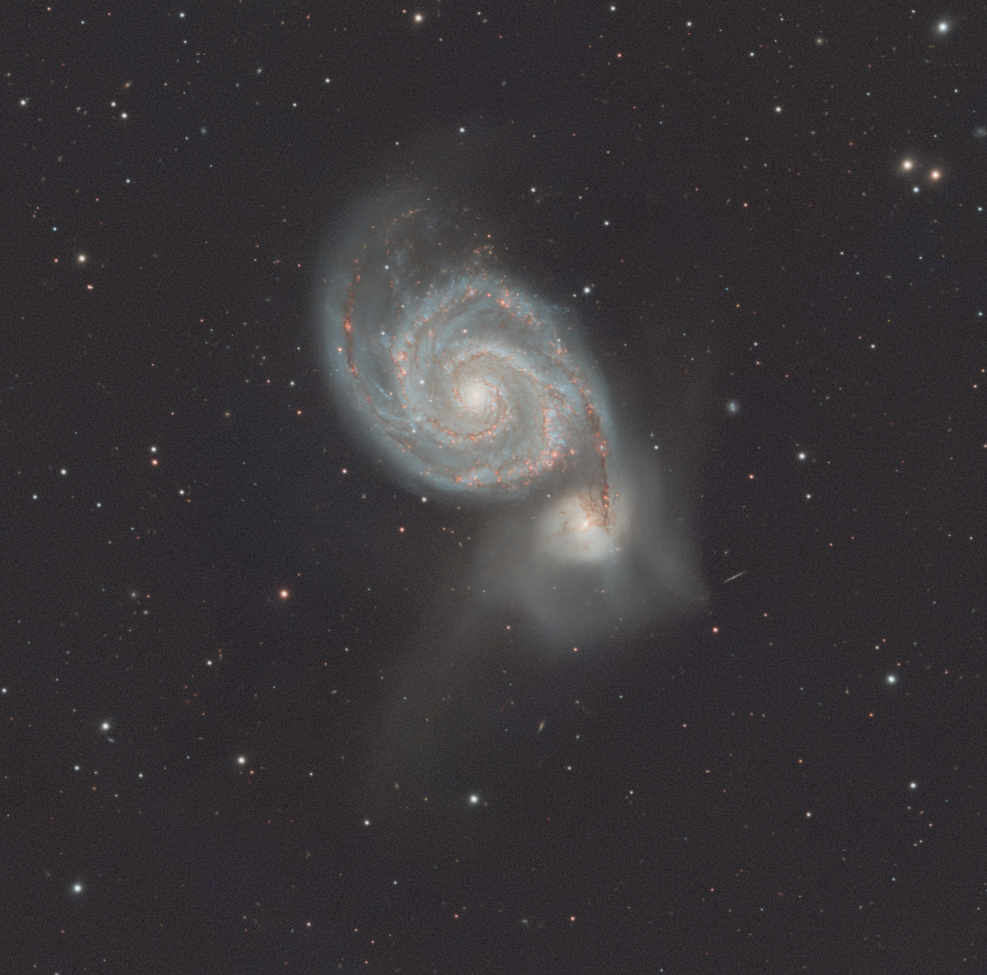 |
You cannot like this item. Reason: "ANONYMOUS".
You cannot remove your like from this item.
Editing a post is only allowed within 24 hours after creating it.
You cannot Like this post because the topic is closed.
Copy the URL below to share a direct link to this post.
This post cannot be edited using the classic forums editor.
To edit this post, please enable the "New forums experience" in your settings.
John Hulme:
I live and image in a Bortle 7 area. I found that my UV/IR cut clear L filter resulted in unusable Luminance data. Other members of my astronomy society tend to use narrowband images because of similar issues. In which sense is your luminance data unusable ? I'm surprised because I image also from Bortle 7, using an UV/IR cut for luminance, and don't have any particular issue with the data. Of course I'd get better data from Bortle 1, but nothing that prevents me to get decent images. The key is to use rather short exposures (60sec or less), to stack many of them (300 or more), and to be rigorous with gradient removal. One example :  Clear skies, Dan
|
You cannot like this item. Reason: "ANONYMOUS".
You cannot remove your like from this item.
Editing a post is only allowed within 24 hours after creating it.
You cannot Like this post because the topic is closed.
Copy the URL below to share a direct link to this post.
This post cannot be edited using the classic forums editor.
To edit this post, please enable the "New forums experience" in your settings.
Maybe not entirely same, but similar … recently a similar method was tried using an SVBONY SV226 quad band filter … on top of a narrow band filter. Worth a view …
https://youtu.be/kYQImk6mpnI?si=xGFtl6OI6JKlb7yw Frank seems to know his stuff
|
You cannot like this item. Reason: "ANONYMOUS".
You cannot remove your like from this item.
Editing a post is only allowed within 24 hours after creating it.
You cannot Like this post because the topic is closed.
Copy the URL below to share a direct link to this post.
This post cannot be edited using the classic forums editor.
To edit this post, please enable the "New forums experience" in your settings.
John Hulme:
I live and image in a Bortle 7 area. I found that my UV/IR cut clear L filter resulted in unusable Luminance data. Other members of my astronomy society tend to use narrowband images because of similar issues.
In which sense is your luminance data unusable ? I'm surprised because I image also from Bortle 7, using an UV/IR cut for luminance, and don't have any particular issue with the data. Of course I'd get better data from Bortle 1, but nothing that prevents me to get decent images.
The key is to use rather short exposures (60sec or less), to stack many of them (300 or more), and to be rigorous with gradient removal.
One example :

Clear skies,
Dan
It may just be my particular location. I back on to a playing field but the other side of the field is a brightly lit supermarket. I have tried upwards of 700 15 second subframes and still end up with a complete mess. (My scope is f2.8 which may be the issue. Regards, John
|
You cannot like this item. Reason: "ANONYMOUS".
You cannot remove your like from this item.
Editing a post is only allowed within 24 hours after creating it.
You cannot Like this post because the topic is closed.
Copy the URL below to share a direct link to this post.
This post cannot be edited using the classic forums editor.
To edit this post, please enable the "New forums experience" in your settings.
Arpad R:
I have the same issue, it's impossible to capture broadband from my location due to the severe LP, especially when I look south. I've thought of maybe trying a quadband or broadband filter like the l-pro. I wouldn't really use a dualband filter as that would basically be equivalent to using narrowband filters which doesn't work on galaxies.
I've also thought of using an IR pass filter for luminance on dark nebulae and galaxies though that has it's own difficulties and I've never seen anyone use this method to counter light pollution and bad seeing, there must be good reasons for this. I have only recently tried this method. It is galaxy season and there haven't been many large objects available. My field of view is (roughly) 2.5 x 1.5 so I don't generally image small galaxies. I did manage one image of a nebula but I am not happy with the processing 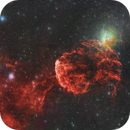
Jellyfish Nebula (IC443) from Bortle 7Regards, John
|
You cannot like this item. Reason: "ANONYMOUS".
You cannot remove your like from this item.
Editing a post is only allowed within 24 hours after creating it.
You cannot Like this post because the topic is closed.
Copy the URL below to share a direct link to this post.
This post cannot be edited using the classic forums editor.
To edit this post, please enable the "New forums experience" in your settings.
I just finished up my project with the sort exposure 60sec for the L and 90 for the RGB, its not that bad but its better from nothing https://www.astrobin.com/492mv9/ |
You cannot like this item. Reason: "ANONYMOUS".
You cannot remove your like from this item.
Editing a post is only allowed within 24 hours after creating it.
You cannot Like this post because the topic is closed.
Copy the URL below to share a direct link to this post.
This post cannot be edited using the classic forums editor.
To edit this post, please enable the "New forums experience" in your settings.
John Hulme:
I live and image in a Bortle 7 area. I found that my UV/IR cut clear L filter resulted in unusable Luminance data. Other members of my astronomy society tend to use narrowband images because of similar issues.
In which sense is your luminance data unusable ? I'm surprised because I image also from Bortle 7, using an UV/IR cut for luminance, and don't have any particular issue with the data. Of course I'd get better data from Bortle 1, but nothing that prevents me to get decent images.
The key is to use rather short exposures (60sec or less), to stack many of them (300 or more), and to be rigorous with gradient removal.
One example :

Clear skies,
Dan
I live a few streets away from the original poster, and I too cannot take Lumimance from Home, we have the London LP to contend with and I have swirling gradients all over the image rendering luminance unusable. Like John says I stick to narrowband at home. I did buy an IDAS Hutech filter at one point, and depending where I point in the sky it is occasionally helpful. I have given up on broadband from where we live. I go to Campsites in Bortle 4 to do Broadband. John Has been describing his method to me and I found it difficult to get my head around it, and am surprised he has managed to do what he has done so far. However he has managed to image some targets I would have thought impossible from here, albeit maybe in the wrong wavelengths.
|
You cannot like this item. Reason: "ANONYMOUS".
You cannot remove your like from this item.
Editing a post is only allowed within 24 hours after creating it.
You cannot Like this post because the topic is closed.
Copy the URL below to share a direct link to this post.
This post cannot be edited using the classic forums editor.
To edit this post, please enable the "New forums experience" in your settings.
Carastro:
John Hulme:
I live and image in a Bortle 7 area. I found that my UV/IR cut clear L filter resulted in unusable Luminance data. Other members of my astronomy society tend to use narrowband images because of similar issues.
In which sense is your luminance data unusable ? I'm surprised because I image also from Bortle 7, using an UV/IR cut for luminance, and don't have any particular issue with the data. Of course I'd get better data from Bortle 1, but nothing that prevents me to get decent images.
The key is to use rather short exposures (60sec or less), to stack many of them (300 or more), and to be rigorous with gradient removal.
One example :

Clear skies,
Dan
I live a few streets away from the original poster, and I too cannot take Lumimance from Home, we have the London LP to contend with and I have swirling gradients all over the image rendering luminance unusable. Like John says I stick to narrowband at home. I did buy an IDAS Hutech filter at one point, and depending where I point in the sky it is occasionally helpful. I have given up on broadband from where we live. I go to Campsites in Bortle 4 to do Broadband.
John Has been describing his method to me and I found it difficult to get my head around it, and am surprised he has managed to do what he has done so far. However he has managed to image some targets I would have thought impossible from here, albeit maybe in the wrong wavelengths. Thanks Carole. My aim is to get the best and most interesting image I can. I appreciate that I miss out on parts of the spectrum and that galaxies are probably not the ideal targets, neither from my fairly wide field scope nor an Ha/Oiii filter. However, I feel that I can get a pleasing result when previously it was impossible. eg: 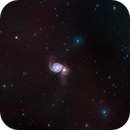
M51 HaO, RGBI appreciate all of the viewpoints and suggestions. Regards, John
|
You cannot like this item. Reason: "ANONYMOUS".
You cannot remove your like from this item.
Editing a post is only allowed within 24 hours after creating it.
You cannot Like this post because the topic is closed.
Copy the URL below to share a direct link to this post.
This post cannot be edited using the classic forums editor.
To edit this post, please enable the "New forums experience" in your settings.
John Hulme:
I live and image in a Bortle 7 area. I found that my UV/IR cut clear L filter resulted in unusable Luminance data. Other members of my astronomy society tend to use narrowband images because of similar issues.
As a last resort I decided to replace my clear Luminance filter with a dual band filter. In case I miss data at other frequencies I add RGB data divided by an arbitrary value of 4 in Pixinsight/Pixelmath to create a "SuperLuminance". I am quite pleased with the improvement in my images (to my eye at least). I have not seen this method described elsewhere but I am sure that others must be using it.
Does anyone have tips for further improvements of this method?
Camera: ZWO ASI1600MM Pro (Mono camera)
This a crop of M94 from a much wider field (approx one fifth of the original image) taken with Dual Band + (RGB/4) as Luminance and HaRGB Colour:
 So using this filter for lum is clearly wrong. You are cutting out lots of viable lum photons and probably some light pollution photons. Very bad. Except, your image is truly excellent. I'm a nearly noob, so bare that in mind. So either current thinking is inaccurate or you've left something on the table, as it were. Personally i'd go with science and current thinking is correct, which means your image could be even better. Which I'm also struggling to see how  When bad news is really two kinds of good news  |
You cannot like this item. Reason: "ANONYMOUS".
You cannot remove your like from this item.
Editing a post is only allowed within 24 hours after creating it.
You cannot Like this post because the topic is closed.
Copy the URL below to share a direct link to this post.
This post cannot be edited using the classic forums editor.
To edit this post, please enable the "New forums experience" in your settings.
John Hulme:
John Hulme:
I live and image in a Bortle 7 area. I found that my UV/IR cut clear L filter resulted in unusable Luminance data. Other members of my astronomy society tend to use narrowband images because of similar issues.
In which sense is your luminance data unusable ? I'm surprised because I image also from Bortle 7, using an UV/IR cut for luminance, and don't have any particular issue with the data. Of course I'd get better data from Bortle 1, but nothing that prevents me to get decent images.
The key is to use rather short exposures (60sec or less), to stack many of them (300 or more), and to be rigorous with gradient removal.
One example :

Clear skies,
Dan
It may just be my particular location. I back on to a playing field but the other side of the field is a brightly lit supermarket. I have tried upwards of 700 15 second subframes and still end up with a complete mess. (My scope is f2.8 which may be the issue.
Regards,
John *** Type your reply here ** F stop doesn't really effect light pollution. You're sucking in many photons, but same proportion of LP photons?
|
You cannot like this item. Reason: "ANONYMOUS".
You cannot remove your like from this item.
Editing a post is only allowed within 24 hours after creating it.
You cannot Like this post because the topic is closed.
Copy the URL below to share a direct link to this post.
This post cannot be edited using the classic forums editor.
To edit this post, please enable the "New forums experience" in your settings.
TiffsAndAstro:
John Hulme:
John Hulme:
I live and image in a Bortle 7 area. I found that my UV/IR cut clear L filter resulted in unusable Luminance data. Other members of my astronomy society tend to use narrowband images because of similar issues.
In which sense is your luminance data unusable ? I'm surprised because I image also from Bortle 7, using an UV/IR cut for luminance, and don't have any particular issue with the data. Of course I'd get better data from Bortle 1, but nothing that prevents me to get decent images.
The key is to use rather short exposures (60sec or less), to stack many of them (300 or more), and to be rigorous with gradient removal.
One example :

Clear skies,
Dan
It may just be my particular location. I back on to a playing field but the other side of the field is a brightly lit supermarket. I have tried upwards of 700 15 second subframes and still end up with a complete mess. (My scope is f2.8 which may be the issue.
Regards,
John
*** Type your reply here **
F stop doesn't really effect light pollution. You're sucking in many photons, but same proportion of LP photons? The F figure means that my frames saturate very quickly.
|
You cannot like this item. Reason: "ANONYMOUS".
You cannot remove your like from this item.
Editing a post is only allowed within 24 hours after creating it.
You cannot Like this post because the topic is closed.
Copy the URL below to share a direct link to this post.
This post cannot be edited using the classic forums editor.
To edit this post, please enable the "New forums experience" in your settings.
John Hulme:
TiffsAndAstro:
John Hulme:
John Hulme:
I live and image in a Bortle 7 area. I found that my UV/IR cut clear L filter resulted in unusable Luminance data. Other members of my astronomy society tend to use narrowband images because of similar issues.
In which sense is your luminance data unusable ? I'm surprised because I image also from Bortle 7, using an UV/IR cut for luminance, and don't have any particular issue with the data. Of course I'd get better data from Bortle 1, but nothing that prevents me to get decent images.
The key is to use rather short exposures (60sec or less), to stack many of them (300 or more), and to be rigorous with gradient removal.
One example :

Clear skies,
Dan
It may just be my particular location. I back on to a playing field but the other side of the field is a brightly lit supermarket. I have tried upwards of 700 15 second subframes and still end up with a complete mess. (My scope is f2.8 which may be the issue.
Regards,
John
*** Type your reply here **
F stop doesn't really effect light pollution. You're sucking in many photons, but same proportion of LP photons?
The F figure means that my frames saturate very quickly. Why don't you shoot shorter subs then ? Appart from this, several things help, like using a flocked dew shield, blackening the secondary mirror edge, chasing all possible light leaks (focuser, back of the mirror cell, etc.), and performing a linear gradient removal on the calibrated subs before stacking.
|
You cannot like this item. Reason: "ANONYMOUS".
You cannot remove your like from this item.
Editing a post is only allowed within 24 hours after creating it.
You cannot Like this post because the topic is closed.
Copy the URL below to share a direct link to this post.
This post cannot be edited using the classic forums editor.
To edit this post, please enable the "New forums experience" in your settings.
I use an L-Pro, Optolong Quad Enhance, or antlia Quadband in place of luminance in my bortle 9 skies.
|
You cannot like this item. Reason: "ANONYMOUS".
You cannot remove your like from this item.
Editing a post is only allowed within 24 hours after creating it.
You cannot Like this post because the topic is closed.
Copy the URL below to share a direct link to this post.
This post cannot be edited using the classic forums editor.
To edit this post, please enable the "New forums experience" in your settings.








